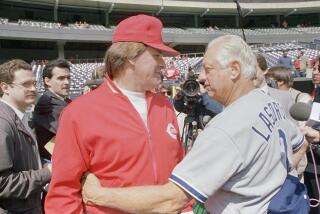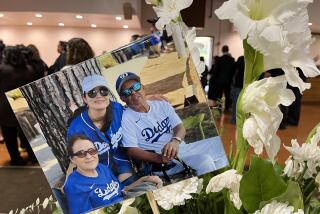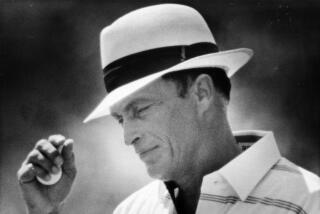It’s No Golden Error to Have Diegel in Hall
The World Golf Hall of Fame made news this week when it announced three inductees -- current player Nick Price, 1920s star Leo Diegel and Japanese LPGA veteran Chako Higuchi. Annika Sorenstam also will be inducted at a ceremony in St. Augustine, Fla., on Oct. 20, when the only honoree not attending will be Diegel, who died in 1951.
There are 99 members in the Hall, which started admitting its legends in 1974, when everyone from Bobby Jones to Walter Hagen to Gene Sarazen to Byron Nelson to Ben Hogan to Sam Snead to Jack Nicklaus, Arnold Palmer, Gary Player and Babe Zaharias formed the first power bunch.
There aren’t any major omissions at the Hall, only a few small questions about some of the membership, which not long ago adopted rules that changed the selection to something more than a popularity contest. Chi Chi Rodriguez (class of ‘92) is as colorful as they come, but he won only eight times, never a major. And Ben Crenshaw is in, but Tom Kite is out?
None of this should be viewed too seriously or critically, especially in light of the selection of Price, who was the pre-Tiger era’s dominant player and a worthy Hall of Fame member. Higuchi, who earned her membership in the Lifetime Achievement category, was a charter member of the Japan’s LPGA. She’s still the JLPGA chairman.
Then there’s Diegel. Even though golf is one of the better sports about remembering its past, the inclusion of Diegel through the Veterans category is worth noting, and not only because he died 52 years ago. Maybe they found a few extra birdies in the last five decades to make him more worthy.
Actually, Diegel stands on his own, and among his most prominent supporters is Byron Nelson, who said it’s long overdue for Diegel to receive lasting recognition. Nelson, 91, said Diegel always called him “Kid” and that he was fortunate to have made his acquaintance.
There’s a good reason why Nelson feels that way. Nelson says if it hadn’t been for a brief conversation with Diegel on June 17, 1945, Nelson’s record 11-tournament winning streak would have stopped at six.
Nelson says he was unaware that Jug McSpaden had taken the lead on the last day of the Philadelphia Inquirer Invitational at Llanerch Country Club. “Kid,” Diegel told Nelson, “you’ve got to make some birdies.” So Nelson made five on his way in, beat McSpaden and the streak reached seven.
Diegel’s career as a touring pro ended in 1935 when he was forced to retire at 36 because of a hand injury. Before then, Diegel was a major force in a Golden Age of golf dominated by Jones, Sarazen, Hagen and Tommy Armour. Diegel won 31 times, including the PGA Championship in 1928 and 1929.
Diegel, runner-up to Jones at the 1930 British Open at Hoylake, won the Canadian Open four times and was a member of the first four U.S. Ryder Cup teams.
Besides that, who else has a putting style named after him? Diegel invented “diegeling,” basically because spreading his legs, pointing both elbows pointed out parallel to his chest and sticking his chin on top of the shaft of the putter was the only way Diegel could get the ball to roll into the hole.
Alas, that particular style worked only for a while, although the name lived on.
Nelson said he doesn’t have any words to describe it, nor enough imagination to draw it. “Jerky,” Nelson called it.
If Diegel had problems putting, he also had legendary problems with his nerves.
In the 1933 British Open at St. Andrews, Diegel came to the last green with a short putt to tie, but yanked it a foot wide. Denny Shute beat Craig Wood in a playoff. So much for diegeling.
At the U.S. Open, Diegel was second in 1920, third in 1926 and 1931 and fourth in 1932. He once said that people kept trying to give him a championship, but he wouldn’t take it.
Hagen, who was his closest pal, knew well of Diegel’s raging nerves. At the 1929 British Open at Muirfield, Hagen trailed Diegel by two shots with only the 36-hole finale to play. But the night before, Hagen was not worried, extending his evening’s fun even though somebody told him Diegel was already in bed.
Yes, Hagen agreed, but Diegel wouldn’t be sleeping. Hagen won by six shots the next day.
They remained buddies, Hagen and Diegel, and even made a movie together in 1930. It was a Mack Sennett comedy called “Match Play,” filmed at El Cabellero Country Club. Hagen and Diegel played hard together, on and off the course, so when Diegel died of cancer in 1951, Hagen and pro Joe Kirkwood drove to the funeral in Diegel’s hometown of Detroit.
Hagen and Kirkwood got lost, went to the wrong church and missed the funeral, but they did arrive at the cemetery for Diegel’s burial. Diegel was buried with his putter. When all the mourners had gone, Hagen pulled a six-pack of beer from his car and put them on the casket. Hagen sat at the head of the casket, emptied the cans and talked to Diegel about all the good times, tapping the casket to make his points.
Hagen even wondered aloud how they managed to get Diegel in there, you know, with his elbows.
Hagen’s parting line is a classic: “May you and your putter rust in peace.”
So welcome, Leo Diegel, to the World Golf Hall of Fame, where diegeling is finally getting its due, same as you.
More to Read
Go beyond the scoreboard
Get the latest on L.A.'s teams in the daily Sports Report newsletter.
You may occasionally receive promotional content from the Los Angeles Times.










